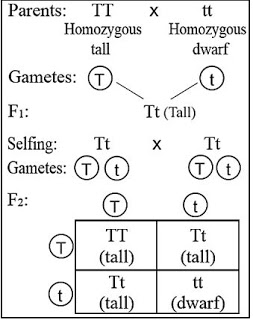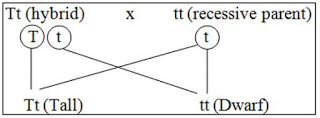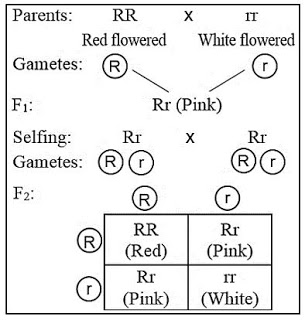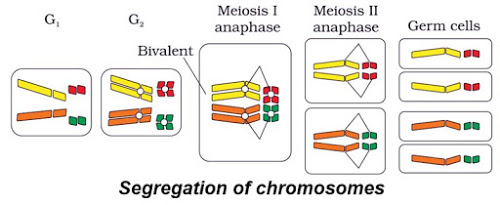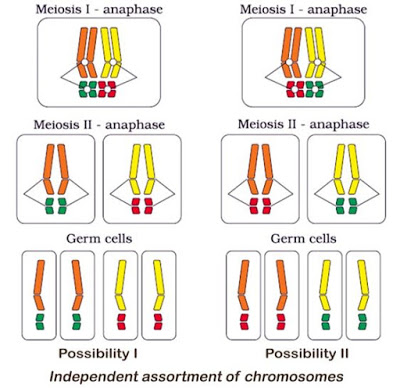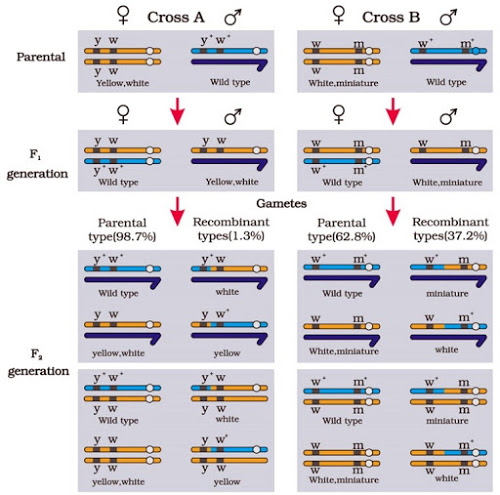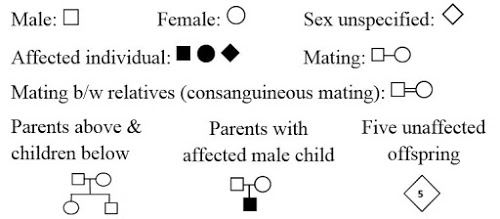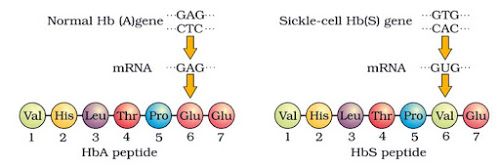Principles of Inheritance and Variation : Notes and Study Materials -pdf
Notes and Study Materials
- Concepts of Principles of Inheritance and Variation
- Master File Principles of Inheritance and Variation
- NCERT Book chapter Principles of Inheritance and Variation
- NCERT Solutions for – Principles of Inheritance and Variation
- NCERT Exemplar Solutions for – Principles of Inheritance and Variation
- Revision Note of Principles of Inheritance and Variation
- Past Many Years Question papers and Answer of Principles of Inheritance and Variation
- Mind Map of Principles of Inheritance and Variation
Examples and Exercise
5. PRINCIPLES OF INHERITANCE AND VARIATION
IMPORTANT TERMS
- Genetics: Study of inheritance, heredity and variation of characters or Study of genes and chromosomes.
- Inheritance: Transmission of characters from parents to progeny. It is the basis of Heredity.
- Variation: Difference between parents and offspring.
- Character: A heritable feature among the parents & offspring. E.g. Eye colour.
- Trait: Variants of a character. E.g. Brown eye, Blue eye.
- Allele: Alternative forms of a gene. E.g. T (tall) and t (dwarf) are two alleles of a gene for the character height.
- Homozygous: The condition in which chromosome pair carries similar alleles of a gene. Also known as pure line (True breeding). E.g. TT, tt, YY, yy etc.
- Heterozygous: The condition in which chromosome pair carries dissimilar alleles of a gene. E.g. Tt, Yy etc.
- Dominant character: The character which is expressed in heterozygous condition. It indicates with capital letter.
- Recessive character: The character which is suppressed in heterozygous condition. It indicates with small letter.
- Phenotype: Physical expression of a character.
- Genotype: Genetic constitution of a character.
- Hybrid: An individual produced by the mating of genetically unlike parents.
- Punnett square: A graphical representation to calculate probability of all genotypes of offspring in a genetic cross.
MENDEL’S LAWS OF INHERITANCE
Gregor Mendel is the Father of genetics.
He conducted some hybridization experiments on garden peas (Pisum sativum) for 7 years (1856-1863).
Steps in making a cross (Deliberate mating) in pea:
- Selection of 2 pea plants with contrasting characters.
- Emasculation: Removal of anthers of one plant to avoid self-pollination. This is female parent.
- Pollination: Collection of pollen grains from the male parent and transferring to female parent.
- Collection & germination of seeds to produce offspring.
Mendel selected 7 pairs of true breeding pea varieties:
7 Characters | Contrasting Traits | |
Dominant | Recessive | |
1. Stem height | Tall | Dwarf |
2. Flower colour | Violet | White |
3. Flower position | Axial | Terminal |
4. Pod shape | Inflated | Constricted |
5. Pod colour | Green | Yellow |
6. Seed shape | Round | Wrinkled |
7. Seed colour | Yellow | Green |
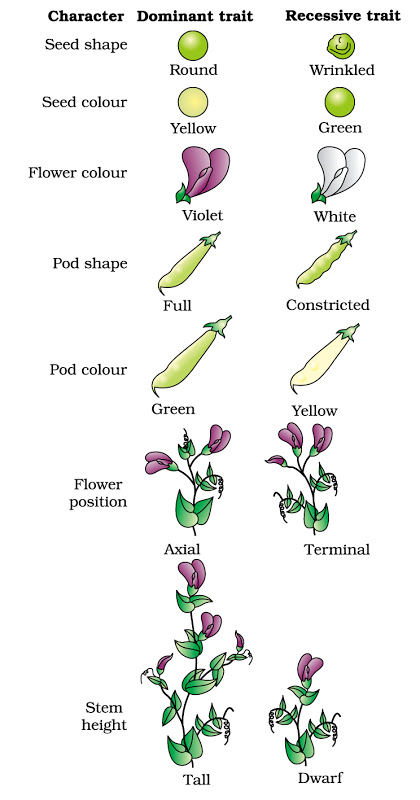
INHERITANCE OF ONE GENE
Monohybrid cross: A cross involving 2 plants differing in one character pair. E.g. Mendel crossed tall and dwarf pea plants to study the inheritance of one gene.
Monohybrid phenotypic ratio:
3 Tall: 1 Dwarf = 3:1
Monohybrid genotypic ratio:
1 Homozygous tall (TT)
2 Heterozygous tall (Tt)
1 Homozygous dwarf (tt)
= 1:2:1
Mendel made similar observations for other pairs of traits. He proposed that some factors were inherited from parent to offspring. Now it is called as genes.
Do not use T for tall and d for dwarf because it is difficult to remember whether T & d are alleles of same gene or not.
The F1 (Tt) when self-pollinated, produces gametes T and t in equal proportion. During fertilization, pollen grains of T have 50% chance to pollinate eggs of T & t. Also, pollen grains of t have 50% chance to pollinate eggs of T and t.
1/4th of the random fertilization leads to TT (¼ TT).
1/2 (2/4) of the random fertilization leads to Tt (½ Tt).
1/4th of the random fertilization leads to tt (¼ tt).
Binomial expression = (ax + by) 2Hence (½ T + ½ t) 2= (½ T + ½ t) (½ T + ½ t)= ¼ TT + ¼ Tt + ¼ Tt + ¼ tt= ¼ TT + ½ Tt + ¼ tt
Backcross: Cross between a hybrid and its any parent.
Testcross: Crossing of an organism with dominant phenotype to a recessive individual. E.g.
Hence monohybrid test cross ratio= 1:1
Test cross is used to find out the unknown genotype of a character. E.g.
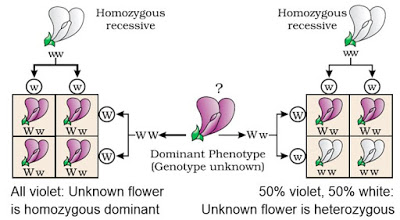
Mendel conducted test cross to determine the F2 genotype.
1. First Law (Law of Dominance)
- Characters are controlled by discrete units called factors.
- Factors occur in pairs.
- In a dissimilar pair of factors, one member of the pair dominates (dominant) the other (recessive).
2. Second Law (Law of Segregation)
“During gamete formation, the factors (alleles) of a character pair present in parents segregate from each other such that a gamete receives only one of the 2 factors”.
Homozygous parent produces similar gametes.
Heterozygous parent produces two kinds of gametes.
INHERITANCE OF TWO GENES
It is a cross between two parents differing in 2 pairs of contrasting characters.
E.g. Cross b/w pea plant with homozygous round shaped & yellow coloured seeds (RRYY) and wrinkled shaped & green coloured seeds (rryy).
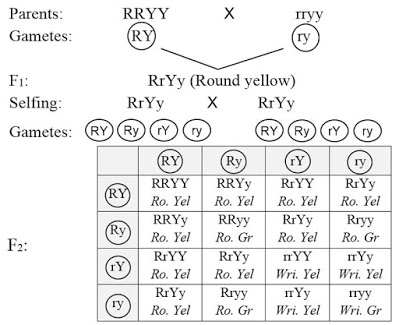
On observing the F2, Mendel found that yellow and green colour segregated in a 3:1 ratio.
Round & wrinkled seed shape also segregated in a 3:1 ratio.
Dihybrid Phenotypic ratio:
9 Round yellow: 3 Round green: 3 Wrinkled yellow: 1 Wrinkled green = 9:3:3:1
The ratio of 9:3:3:1 can be derived as a combination series of 3 yellow: 1 green, with 3 round: 1 wrinkled.
i.e. (3: 1) (3: 1) = 9: 3: 3: 1
Dihybrid genotypic ratio:
1:2:1:2:4:2:1:2:1RRYY =1RRYy =2RrYY =2RrYy =4RRyy =1Rryy =2rrYY =1rrYy =2rryy =1
It is based on the results of dihybrid crosses.
It states that “When two pairs of traits are combined in a hybrid, segregation of one pair of characters is independent of the other pair of characters”.
Every gene contains information to express a particular trait.
In heterozygotes, there are 2 types of alleles:
- Unmodified (normal or functioning) allele: It is generally dominant and represents original phenotype.
- Modified allele: It is generally recessive.
E.g. Consider a gene that contains information for producing an enzyme. Normal allele of that gene produces a normal enzyme. Modified allele is responsible for production of
- Normal/less efficient enzyme or
- A non-functional enzyme or
- No enzyme at all
In the first case: The modified allele will produce the same phenotype like unmodified allele. Thus, modified allele is equivalent to unmodified allele.
In 2nd and 3rd cases: The phenotype will dependent only on the functioning of the unmodified allele. Thus the modified allele becomes recessive.
1. Incomplete Dominance
It is an inheritance in which heterozygous offspring shows intermediate character b/w two parental characteristics.
E.g. Flower colour in snapdragon (dog flower or Antirrhinum sp.) and Mirabilis jalapa (4’O clock plant).
Here, cross between homozygous red & white produces pink flowered plant. Thus phenotypic & genotypic ratios are same.
Phenotypic ratio= 1 Red: 2 Pink: 1 White (1:2:1)
Genotypic ratio= 1 (RR): 2 (Rr): 1(rr)
This means that R was not completely dominant over r.
Pea plants also show incomplete dominance in other traits.
2. Co-dominance
It is the inheritance in which both alleles of a gene are expressed in a hybrid.
E.g. ABO blood grouping in human.
ABO blood groups are controlled by the gene I.
This gene controls the production of sugar polymers (antigens) that protrude from plasma membrane of RBC.
The gene I has three alleles IA, IB & i.
IA and IB produce a slightly different form of the sugar while allele i doesn’t produce any sugar.
Alleles from parent 1 | Alleles from parent 2 | Genotype of offspring | Blood types (phenotype) |
IA | IA | IA IA | A |
IA | IB | IA IB | AB |
IA | i | IAi | A |
IB | IA | IA IB | AB |
IB | IB | IB IB | B |
IB | i | IBi | B |
i | i | ii | O |
When IA and IB are present together, they both express their own types of sugars. This is due to co-dominance.
3. Multiple allelism
It is the presence of more than two alleles of a gene to govern same character.
E.g. ABO blood grouping (3 alleles: IA, IB & i).
In an individual, only two alleles are present. Multiple alleles can be found only in a population.
4. Polygenic inheritance
It is the inheritance in which some traits are controlled by several genes (multiple genes).
E.g. human skin colour, human height etc.
It considers the influence of environment.
In a polygenic trait, the phenotype reflects the contribution of each allele, i.e., the effect of each allele is additive.
Human skin colour:
Assume that 3 genes A, B, C control human skin colour.
The dominant forms A, B & C responsible for dark skin colour and recessive forms a, b & c for light skin colour.
Genotype with all the dominant alleles (AABBCC) gives darkest skin colour.
Genotype with all the recessive alleles (aabbcc) gives lightest skin colour.
Therefore, genotype with 3 dominant alleles and 3 recessive alleles gives an intermediate skin colour.
Thus, number of each type of alleles determines the darkness or lightness of the skin.
5. Pleiotropy
Here, a single gene exhibits multiple phenotypic expressions. Such a gene is called pleiotropic gene.
In most cases, the mechanism of pleiotropy is the effect of a gene on metabolic pathways which contributes towards different phenotypes.
E.g. Starch synthesis in pea, sickle cell anaemia, phenylketonuria etc.
In Phenylketonuria & sickle cell anaemia, the mutant gene has many phenotypic effects. E.g. Phenylketonuria causes mental retardation, reduction in hair and skin pigmentation.
Starch synthesis in pea plant:
Starch is synthesized effectively by BB gene. Therefore, large starch grains are produced.
bb have lesser efficiency in starch synthesis and produce smaller starch grains.
Starch grain size also shows incomplete dominance.
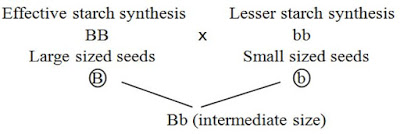
CHROMOSOMAL THEORY OF INHERITANCE
Mendel’s work remained unrecognized till 1900 because,
- Communication was not easy.
- His mathematical approach was new and unacceptable.
- The concept of genes (factors) as stable and discrete units could not explain the continuous variation seen in nature.
- He could not give physical proof for the existence of factors.
In 1900, de Vries, Correns & von Tschermak independently rediscovered Mendel’s results.
Proposed by Walter Sutton & Theodore Boveri.
They said that pairing & separation of a pair of chromosomes lead to segregation of a pair of factors they carried.
Sutton united chromosomal segregation with Mendelian principles and called it the chromosomal theory of inheritance. It states that,
- Chromosomes are vehicles of heredity.
- Two identical chromosomes form a homologous pair.
- Homologous pair segregates during gamete formation.
- Independent pairs segregate independently of each other.
Genes (factors) are present on chromosomes. Hence genes and chromosomes show similar behaviours.
Thomas Hunt Morgan proved chromosomal theory of inheritance using fruit flies (Drosophila melanogaster).
It is the suitable material for genetic study because,
- They can grow on simple synthetic medium.
- Short generation time (life cycle: 12-14 days).
- Breeding can be done throughout the year.
- Hundreds of progenies per mating.
- Male and female flies are easily distinguishable. E.g. Male is smaller than female.
- It has many types of hereditary variations that can be seen with low power microscopes.
Linkage is the physical association of two or more genes on a chromosome. They do not show independent assortment.
Recombination is the generation of non-parental gene combinations. It occurs due to independent assortment or crossing over.
Morgan carried out several dihybrid crosses in Drosophila to study sex-linked genes. E.g.
Cross 1: Yellow-bodied, white-eyed females X Brown-bodied, red-eyed males (wild type)
Cross 2: White-eyed, miniature winged X Red eyed, large winged (wild type)
Morgan intercrossed their F1 progeny. He found that
- The two genes did not segregate independently and the F2 ratio deviated from the 9:3:3:1 ratio.
- Genes were located on the X chromosome.
- When two genes were situated on the same chromosome, the proportion of parental gene combinations was much higher than the non-parental type. This is due to linkage.
- Genes of white eye & yellow body were very tightly linked and showed only 1.3% recombination.
- Genes of white eye & miniature wing were loosely linked and showed 37.2% recombination.
- Tightly linked genes show low recombination. Loosely linked genes show high recombination.
Alfred Sturtevant used the recombination frequency between gene pairs for measuring the distance between genes and ‘mapped’ their position on the chromosome.
Genetic maps are used as a starting point in the sequencing of genomes. E.g. Human Genome Project.
SEX DETERMINATION
They include X & Y chromosomes.
Autosomes are chromosomes other than sex chromosomes.
Number of autosomes is same in males and females.
Henking (1891) studied spermatogenesis in some insects and observed that 50 % of sperm received a nuclear structure after spermatogenesis, and other 50 % sperm did not receive it. Henking called this structure as the X body (now it is called as X-chromosome).
- XX-XO mechanism: Here, male is heterogametic, i.e. XO (Gametes with X and gametes without X) and female is homogametic, i.e. XX (all gametes are with X-chromosomes). E.g. Many insects such as grasshopper.
- XX-XY mechanism: Male is heterogametic (X & Y) and female is homogametic (X only). E.g. Human & Drosophila.
- ZZ-ZW mechanism: Male is homogametic (ZZ) and female is heterogametic (Z & W). E.g. Birds.
XX-XO & XX-XY mechanisms show male heterogamety.
ZZ-ZW mechanism shows female heterogamety.
Human has 23 pairs of chromosomes (22 pairs of autosomes and 1 pair of sex chromosomes).
A pair of X-chromosomes (XX) is present in the female, whereas X and Y chromosomes are present in male.
During spermatogenesis, males produce 2 types of gametes: 50 % with X-chromosome and 50 % with Y-chromosome.
Females produce only ovum with an X-chromosome.
There is an equal probability of fertilization of the ovum with the sperm carrying either X or Y chromosome.
The sperm determines whether the offspring male or female.
It is based on the number of sets of chromosomes an individual receives.
Fertilised egg develops as a female (queen or worker).
An unfertilised egg develops as a male (drone). It is called parthenogenesis.
Therefore, the females are diploid (32 chromosomes) and males are haploid (16 chromosomes). This is called as haplodiploid sex determination system.
In this system, the males produce sperms by mitosis. They do not have father and thus cannot have sons, but have a grandfather and can have grandsons.
It is a sudden heritable change in DNA sequences resulting in changes in the genotype and the phenotype of an organism.
Mutation is 2 types:
- Point mutation: The mutation due to change (substitution) in a single base pair of DNA. E.g. sickle cell anaemia.
- Frame-shift mutation: It is the deletion or insertion of base pairs resulting in the shifting of DNA sequences.
Loss (deletion) or gain (insertion/ duplication) of DNA segment cause Chromosomal abnormalities (aberrations).
Chromosomal aberrations are seen in cancer cells.
The agents which induce mutation are called mutagens. They include
- Physical mutagens: UV radiation, α, β, γ rays, X-ray etc.
- Chemical mutagens: Mustard gas, phenol, formalin etc.
In human, control crosses are not possible. So the study of family history about inheritance is used.
Such an analysis of genetic traits in several generations of a family is called pedigree analysis.
The representation or chart showing family history is called family tree (pedigree).
In human genetics, pedigree study is utilized to trace the inheritance of a specific trait, abnormality or disease.
The disorders due to change in genes or chromosomes.
2 types: Mendelian disorders & Chromosomal disorders.
It is caused by alteration or mutation in the single gene.
E.g. Haemophilia, Colour blindness, Sickle-cell anaemia, Phenylketonuria, Thalassemia, Cystic fibrosis etc.
The pattern of inheritance of Mendelian disorders can be traced in a family by the pedigree analysis.
Mendelian disorders may be dominant or recessive.
Pedigree analysis helps to understand whether the trait is dominant or recessive.
It is a sex linked (X-linked) recessive disease.
In this, a protein involved in the blood clotting is affected.
A simple cut results in non-stop bleeding.
The disease is controlled by 2 alleles, H & h.
XHXH | Normal female |
XHXh | Heterozygous female (carrier). She may transmit the disease to sons. |
XhXh | Hemophilic female |
XHY | Normal male |
XhY | Hemophilic male |
In females, haemophilia is very rare because it happens only when mother is at least carrier and father haemophilic (unviable in the later stage of life).
Queen Victoria was a carrier of hemophilia. So her family pedigree shows many haemophilic descendants.
Colour blindness:
It is a sex-linked (X-linked) recessive disorder due to defect in either red or green cone of eye. It results in failure to discriminate between red and green colour.
It is due to mutation in some genes in X chromosome.
It occurs in 8% of males and only about 0.4% of females. This is because the genes are X-linked.
Normal allele is dominant (C). Recessive allele (c) causes colour blindness.
The son of a heterozygous woman (carrier, XCXc) has a 50% chance of being colour blind.
A daughter will be colour blind only when her mother is at least a carrier and her father is colour blind (XcY).
Sickle-cell anaemia:
This is an autosome linked recessive disease.
It can be transmitted from parents to the offspring when both the partners are carrier (heterozygous) for the gene.
The disease is controlled by a pair of allele, HbA and HbS.
- Homozygous dominant (HbAHbA): normal
- Heterozygous (HbAHbS): carrier; sickle cell trait
- Homozygous recessive (HbSHbS): affected
The defect is caused by the substitution of Glutamic acid (Glu) by Valine (Val) at the sixth position of the β-globin chain of the haemoglobin (Hb).
This is due to the single base substitution at the sixth codon of the β-globin gene from GAG to GUG.
The mutant Hb molecule undergoes polymerization under low oxygen tension causing the change in shape of the RBC from biconcave disc to elongated sickle like structure.
Phenylketonuria:
An inborn error of metabolism.
Autosomal recessive disease.
It is due to mutation of a gene that codes for the enzyme phenyl alanine hydroxylase. This enzyme converts an amino acid phenylalanine into tyrosine.
The affected individual lacks this enzyme. As a result, phenylalanine accumulates and converts into phenyl pyruvic acid and other derivatives.
They accumulate in brain resulting in mental retardation. These are also excreted through urine because of poor absorption by kidney.
Thalassemia:
An autosome-linked recessive blood disease.
It is transmitted from unaffected carrier (heterozygous) parents to offspring.
It is due to mutation or deletion.
It results in reduced synthesis of α or β globin chains of haemoglobin. It forms abnormal haemoglobin and causes anaemia.
Based on the chain affected, thalassemia is 2 types:
- α Thalassemia: Here, production of α globin chain is affected. It is controlled by two closely linked genes HBA1 & HBA2 on chromosome 16 of each parent. Mutation or deletion of one or more of the four genes causes the disease. The more genes affected, the less α globin molecules produced.
- β Thalassemia: Here, production of β globin chain is affected. It is controlled by a single gene HBB on chromosome 11 of each parent. Mutation of one or both the genes causes the disease.
Thalassemia is a quantitative problem (synthesise very less globin molecules).
Sickle-cell anaemia is a qualitative problem (synthesise incorrectly functioning globin).
They are caused due to absence or excess or abnormal arrangement of one or more chromosomes.
2 types:
- Aneuploidy: The gain or loss of chromosomes due to failure of segregation of chromatids during cell division.
- Polyploidy (Euploidy): It is an increase in a whole set of chromosomes due to failure of cytokinesis after telophase stage of cell division. This is very rare in human but often seen in plants.
Down’s syndrome:
It is the presence of an additional copy of chromosome number 21 (trisomy of 21).
Genetic constitution: 45 A + XX or 45 A + XY (i.e. 47 chromosomes).
Features:
- They are short statured with small round head.
- Broad flat face.
- Furrowed big tongue and partially open mouth.
- Many “loops” on finger tips.
- Broad palm with characteristic palm simian crease.
- Retarded physical, psychomotor & mental development.
- Congenital heart disease.
Klinefelter’s Syndrome:
It is the presence of an additional copy of X-chromosome in male (trisomy).
Genetic constitution: 44 A + XXY (i.e. 47 chromosomes).
Features:
- Overall masculine development. However, the feminine development is also expressed. E.g. Development of breast (Gynaecomastia).
- Sterile.
- Mentally retarded.
- Turner’s syndrome: This is the absence of one X chromosome in female (monosomy).
This is the absence of one X chromosome in female (monosomy).
Genetic constitution: 44 A + X0 (i.e. 45 chromosomes).
Features:
- Sterile, Ovaries are rudimentary.
- Lack of other secondary sexual characters.
- Dwarf.
- Mentally retarded.
CBSE Class 12 Biology Important Questions Chapter 5 – Principles of Inheritance and Variation
1 Mark Questions
Chapter 5
Principles of Inheritance and Variation
1 Marks Questions
1. Give any two reasons for the selection of pea plants by Mendel for his experiments.
Ans.(i) Many varieties with contrasting forms of characters
(ii) Can easily be cross pollinated as well as self pollinated.
2. Name any one plant that shows the phenomenon of incomplete dominance during the inheritance of its flower colour.
Ans. Dog flower (Snapdragon or Antirrhinum sp.)
3. Name the base change and the amino acid change, responsible for sickle cell anaemia.
Ans. GAG changes as GUG, Glutamic acid is substituted by valine.
4. Name the disorder with the following chromosome complement.
(i) 22 pairs of autosomes + X X Y
(ii) 22 pairs of autosomes + 21st chromosome + XY.
Ans.(i) Klinefelter’s Syndrome (ii) Downs syndrome
5. A haemophilic man marries a normal homozygous woman. What is the probability that their daughter will be haemophilic?
Ans. Their daughter can never be haemophilic. (0%).
6. A test is performed to know whether the given plant is homozygous dominant or heterozygous. Name the test and phenotypic ratio of this test for a monohybrid cross.
Ans. Test cross 1 : 1.
7. Name the phenomena that occur when homologous chromosomes do not separate during meiosis.
Ans. Non – disjunction.
8. Name one trait each in humans & in drosophila whose genes are located on sex chromosome.
Ans. Humans – Colorblindness
Drosophila – Eye colour
9. What is meant by aneuploidy?
Ans. Aneuploidy is the phenomena of gain or loss of one or more chromosomes that results due to failure of separation of members of homologous pair of chromosomes during meioses.
10. What genetic principle could be derived from a monohybrid cross?
Ans. Law of dominance.
11. Which one change is the cause of sickle – cell anaemia ?
Ans. It is caused due to a point mutation at 6th position in B-chain of hemoglobin in which glutamic acid is replaced by valine.
12. What is a test cross?
Ans. It is a cross where offspring with dominant phenotype whose genotype is not known is crossed with an individual homozygous recessive for the trait.
13. What is mutagen? Give an example?
Ans. The physical or chemical agents that causes mutations are called mutagen eg x-rays, CNBr etc.
14. What was the total number of varieties of garden pea which Mendel had taken to start his experiment?
Ans. fourteen.
15. Name any one plant & its feature that shows the phenomena of incomplete dominance?
Ans. Antirrhium majus which shows incomplete dominance in flower colour.
2 Mark Questions
Chapter 5
Principles of Inheritance and Variation
2 Marks Questions
1. Identify the sex of organism as male or female in which the sex chromosome are found as
(i) ZW in bird (ii) XY in Drosophila (iii) ZZ in birds. (iv) XO in grasshopper.
Ans. (i) Female; (ii) Male; (iii) Female (iv) Male
2. Mention two differences between Turner ’s syndrome and Klinefelter’s syndome.
Ans. Turners Syndrome : The individual is female and it has 45 chromosomes
i.e., one X chromosome is less.
Klinefelters Syndome : The individual is male and has 47 chromosomes
i.e., one extra X chromosome.
3. The human male never passes on the gene for haemophilia to his son. Why is it so?
Ans. The gene for haemophilia is present on X chromosome. A male has only one X chromosome which he receives from his mother and Y chromosome from father. The human male passes the X chromosome to his daughters but not to the male progeny (sons).
4. Mention four reasons why Drosophila was chosen by Morgan for his experiments in genetics.
Ans. (i) Very short life cycle (2-weeks)
(ii) Can be grown easily in laboratory
(iii) In single mating produce a large no. of flies.
(iv) Male and female show many hereditary variations
(v) It has only 4 pairs of chromosomes which are distinct in size and Shape.
5. Differentiate between point mutation and frameshift mutations.
Ans. Point Mutations : Arises due to change in a single base pair of DNA e.g., sickle cell anaemia. Frame shift mutations : Deletion or insertion/duplication/addition of one or two bases in DNA.
6. Give any two similarities between behavior of genes (Mendel’s factor) during inheritance & chromosomes during cell division.
Ans. (i) In diploid cells, the chromosomes are found in pairs just like that of mendelian factors.
(ii)During meiosis, the chromosomes of different homologous pairs are assorted independently into gametes at random showing parallelism with mendelian factors.
7. Which law of Mendel is universally accepted? State the law?
Ans. Mendel’s law of segregation is universally accepted It states that – “the two alleles of a gene remain separate & do not contaminate each other in F1 or the hybrid. At the time of gamete formation two alleles separate & pars into deferent gametes.
8. How will you find out whether a given plant is homozygous or heterozygous?
Ans. To test whether a plant is homozygous or heterozygous, test cross is performed in which individual is crossed with homozygous recessive for the trait. If plant is heterozygous, progeny of test cross consists of tall and dwarf plants in the ratio l:l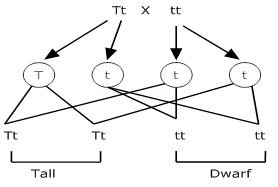
If plant is homozygous, progeny of test cross will have all tall plants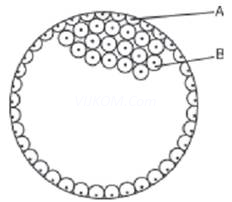
9. Why do sons of haemophilic father never suffer from this trait?
Ans. Since haemophilic is a sex – linked character, it shows criss – cross inheritance i-e from father to his daughter therefore son of haemopilic father is never haemophilic.
10. How is the child affected if it has grown from the zygote formed by an XX-egg fertilized by Y-carrying sperm? What do you call this abnormality?
Ans. If a child has grown from the zygote formed by XX-egg fertilized by Y-sperm, the child will suffer from klinefiter syndrome & will have XXY genotype. It is characterized by prominent feminine characters e.g. tall stature with feminised physique, Breast development pubic hair pattern, poor beard growth & sterility.
11. The map distance in certain organism between genes A & B is 4 units, between B & C is units, & between C & D is 8 units which one of these gene paves will show more recombination frequency? Give reason.
Ans. C& D will show maximum gene recombination because genes which are more closely linked, frequency of recombination is least & vice versa.
12. Give the chromosomal constitution & related sex in each of the following :-
i) Turner syndrome
ii) Klinefilter syndrome
ans. i) Turner syndrome – XO females containing 45 chromosomes & lacking one X-chr .
ii) Klinefilter syndrome XXY males containing 47chr, one extra X-chromosome in males.
13.What is pedigree Analysis? How is it useful?
Ans. The analysis of family history about inheritance of a particular trait in several generations of a family is called pedigree Analysis. It provides a strong tool which is utilized to trace inheritance of specific trait or abnormality or disease.
14. What are multiple alleles? Give an example?
Ans. The presence of more then two alleles of a trait is called multiple alleles e.g. in human beings four types of blood groups are recognized and there different alleles IA IB & IO of a gene determines the phenotype of four blood groups.
3 Mark Questions
Chapter 5
Principles of Inheritance and Variation
3 Marks Questions
1. A woman with O blood group marries a man with AB blood group
(i) work out all the possible phenotypes and genotypes of the progeny.
(ii) Discuss the kind of dominance in the parents and the progeny in this case.
Ans. (i) Blood group AB has alleles as IA, IB and O group has ii which on cross gives the both blood groups A and B while the genotype of progeny will be IAi and IBi.
(ii) IA and IB are equally dominant (co-dominant). In multiple allelism, the gene I exists in 3 allelic forms, IA, IB and i.
2. Explain the cause of Klinefelter’s syndrome. Give any four symptoms shown by sufferer of this syndrome.
Ans. Cause : Presence of an extra chromosome in male i.e., XXY. Symptoms : Development of breast, Female type pubic hair pattern, poor beard growth, under developed testes and tall stature with Feminized physique.
3. In Mendels breeding experiment on garden pea, the offspring of F2 generation are obtained in the ratio of 25% pure yellow pod, 50% hybrid green pods and 25% green pods State (i) which pod colour is dominant (ii) The Phenotypes of the individuals of F1 generation. (iii) Workout the cross.
Ans. (i) Green pod colour is dominant
(ii) Green pod colour
Phenotypic ratio 3 : 1
Genotypic ratio 1 : 2 : 1
4. In Antirrhinum majus a plant with red flowers was crossed with a plant with white flowers. Work out all the possible genotypes & phenotypes of F1 & F2 generations comment on the pattern of inheritance in this case?
Ans. The inheritance of flower colour in snapdragon or Antirrhinum majus is an example of incomplete dominance. When a cross was made between a red flowered plant & a white flowered plant, the F1hybrid was pink i-e-an intermediate between red & white which means that both red & white are incompletely dominant. When F1 individuals was self – pollinated, the F2 generation consists of red, pink & white flower appears in ratio 1:2:1 respectively.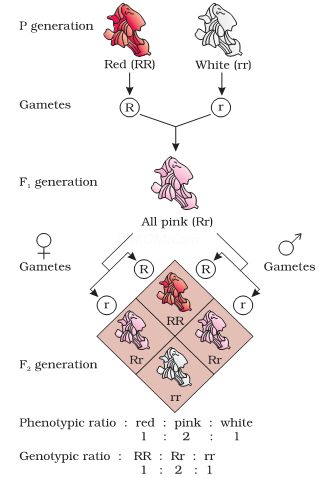
5. A red eyed male fruitfly is crossed with white eyed female fruitfly. Work out the possible genotype & phenotype of F1 & F2 generation. Comment on the pattern of inheritance in this cross?
Ans. When a red eyed is crossed with white eyed female fruitfly, offspring will have both white eyed male & red eyed female in 1:1 ration in F1 generation. In F2 generation, 50% females will be red – eyed & 50% will be white eyed, similarly, in males 50% will be red eyed & 50% will be white eyed. This result indicates that in sex-linked genes, males transmit their sex-linked characters to their grandson through their daughter; such type of inheritance is called criss-cross inheritance –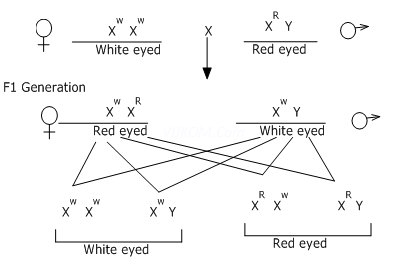
6. A man with AB blood group marries a woman with O group blood.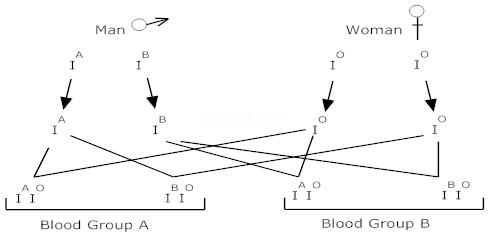
(i) Work out all the possible phenotypes & genotypes of the progeny.
(ii) Discuss the kind of domination in parents & progeny in this case?
Ans. (i) Half the progeny will have blood group A with genotype IA IO & half the progeny will have blood group B with genotype IB IO.
(ii) IA & IB both the genes are dominant over IO gene hence progeny shows either blood group A or B while in parents since both the dominant genes are present together man will have blood group AB & this phenomena is called co-dominance.
7. In an cross made between a hybrid tall & red plant (TtRr) with dwarf & white flower (ttrr). What will be the genotype of plants in F1 generation?
Ans.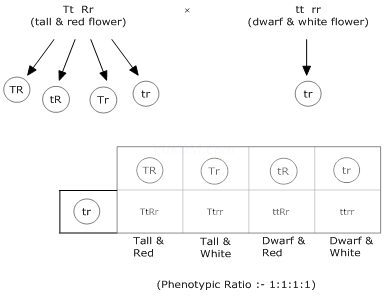
8. How sex is determined in human brings?
Ans. In human beings, it was found that all the females bear a pairs of X-chromosome while males have one X-chr & also one Y-chr which is comparatively smaller in size.
Thus in a cross between male & female there is equal probability of males & females in progeny & sex is determined by presence of a Y-chr. if Y-chr is present it is male otherwise it is a female.
9. A smooth seeded & red – flowered pea plant (SsRr) is crossed with smooth seeded & white flowered pea plant (Ssrr). Determine the phenotypic & genotypic ratio in f1 progeny?
Ans.
- Smooth seed & red flower =3
- Smooth seed & white flower =3
- Rough seed & red flower =1
- Rough seed & white flower =1
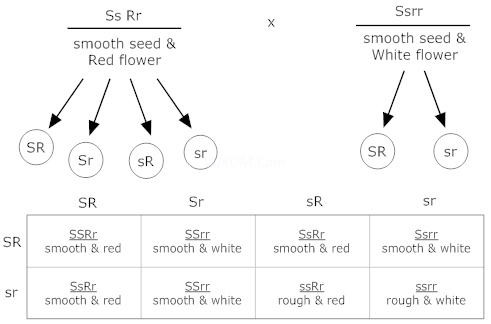
5 Marks Questions
Chapter 5
Principles of Inheritance and Variation
5 Marks Questions
1. A dihybrid heterozygous round, yellow seeded garden pea (Pisum sativum) was crossed with a double recessive plant.
(i) What type of cross is this?
(ii) Work out the genotype and phenotype of the progeny.
(iii) What principle of Mendel is illustrated through the result of this cross?
Ans.(i) It is a dihybrid test cross
(ii)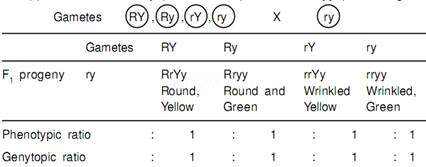
(iii) It illustrates the Principle of independent assortment.
2. In dogs, barking trait is dominant over silent trait & erect ears are dominant over drooping ears. What is the expected phenotypic ratio of offspring when dogs heterozygous for both the traits are crossed?
Ans.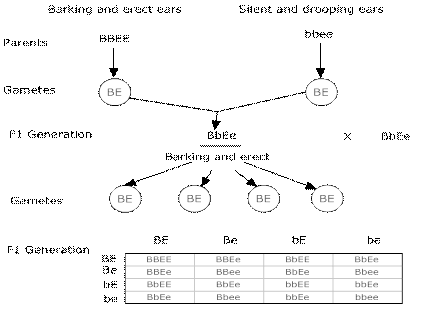
Ration :- Barking & erect = 9
Barking & drooping =3
Silent & erect = 3
Silent & drooping =1
Phenotypic ratio = 9 : 3 : 3 : 1
3. Differentiate between dominance, co-dominance & Incomplete dominance with one example each.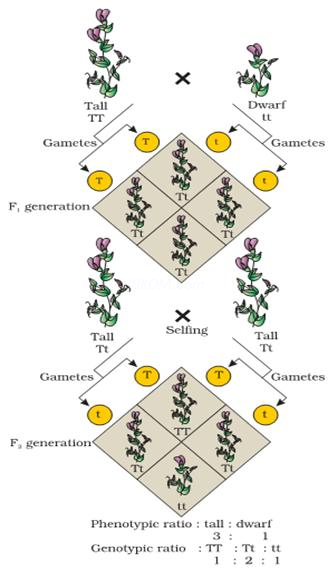
Ans. (i) Dominance :- When a cross is made between true – breeding tall pea plant & true – breeding dwarf pea plant, all the plants in F1 generation are tall this sows that tall character is dominant over dwarf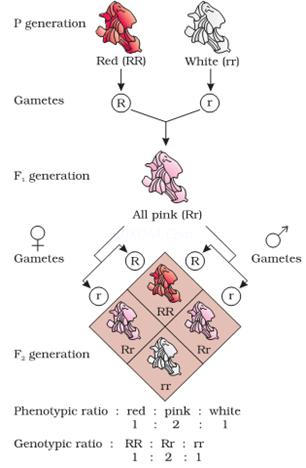
(ii) Co-dominance :- If the two equally dominant genes are present together, both of them will be equally expressed, this phenomena is called co-dominance eg alleles of blood group IA & IB ore dominant over IO but when both the alleles are present together, both of them will equally express & forms a phenotype AB.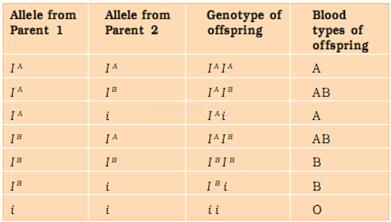
(iii) In complete dominance :- When a cross is made between two characters of which none of them is completely dominant then an intermediate character develops in the progeny eg. when a cross is made between red flower & white flower in snapdragon flower an intermediate pink colour appears in the progeny
4. A dihybrid heterozygous tall & yellow pea plant was crossed with double recessive plant.
(i) What type of cross is this?
(ii) Work out the genotype & phenotype of progeny
(iii) What principle of Mendel is illustrated through result of this cross?
Ans. (i) Test cross.
(ii)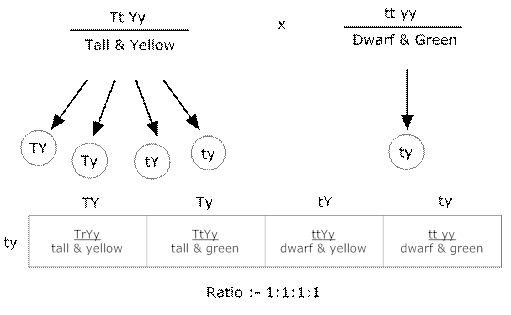
(iii) Principle of Independent Assortment – Acc to which, in the inheritance of contrasting characters the factors of each pair of character segregate independently of the factors of the other pair of characters.
Principles of Inheritance and Variation Class 12 Biology MCQs
1. When ‘Aa’ is crossed with ‘aa’, (A is dominant over a)
(a) all the offspring will have dominant phenotype.
(b) all the offspring will have recessive phenotype.
(c) 50% of offspring will have dominant phenotype and 50% will have recessive phenotype.
(d) 75% of offspring will have dominant phenotype and 50% will have recessive phenotype.
Answer
Answer: c
2. A heterozygous violet-flowered pea plant is crossed to another homozygous violet- flowered pea plant. What percent of the progeny plants will have the recessive trait, i.e., white flowers?
(a) 0%
(b) 25%
(c) 50%
(d) 75%
Answer
Answer: a
3. From a cross AABb x aaBb, the genotypes AaBB : AaBb : Aabb will be obtained in the ratio
(a) 1:1:2
(b) 1:2:1
(c) 2:1:1
(d) 2:1:2
Answer
Answer: b
4. The possibility of all genotypes of offspring in a genetic cross is calculated by a graphical representation which was developed by
(a) Komberg
(b) T.H. Morgan
(c) Gregor Mendel
(d) Reginald Punnett
Answer
Answer: d
5. A woman with normal vision has a colorblind father. She marries a colourblind man. What proportion of their children will be colourblind?
(a) 0%
(b) 25%
(c) 50%
(d) 100%
Answer
Answer: c
6. Study the pedigree chart given
Select the correct option about the conclusion.
(a) It is a sex-linked recessive trait.
(b) It is an autosomal recessive trait.
(c) It is an autosomal dominant trait.
(d) It is a sex-linked dominant trait.
Answer
Answer: b
7. Mother and father of a person with ‘O’ blood group have ‘A’ and ‘B’ blood group respectively. What would be the genotype of both mother and father? [NCERT Exemplar]
(a) Mother is homozygous for ‘A’ blood group and father is heterozygous for ‘B’.
(b) Mother is heterozygous for ‘A’ blood group and father is homozygous for ‘B’.
(c) Both mother and father are heterozygous for ‘A’ and ‘B’ blood group, respectively.
(d) Both mother and father are homozygous for ‘A’ and ‘B’ blood group, respectively.
Answer
Answer: c
8. The inheritance pattern of a gene over generations among humans is studied by the pedigree analysis. Character studied in the pedigree analysis is equivalent to: [NCERT Exemplar]
(a) Quantitative trait.
(b) Mendelian trait.
(c) Polygenic trait.
(d) Maternal trait.
Answer
Answer: b
9. Occasionally, a single gene may express more than one effect. The phenomenon is called: [NCERT Exemplar]
(a) multiple allelism
(b) mosaicism
(c) pleiotropy
(d) polygeny.
Answer
Answer: c
10. Conditions of a karyotype 2n ± 1 and 2n ± 2 are called: [NCERT Exemplar]
(a) Aneuploidy
(b) Polyploidy
(c) Allopolyploidy
(d) Monosomy.
Answer
Answer: a
11. If a genetic disease is transferred from a phenotypically normal but carrier female to only some of the male progeny, the disease is: [NCERT Exemplar]
(a) Autosomal dominant
(b) Autosomal recessive
(c) Sex-linked dominant
(d) Sex-linked recessive.
Answer
Answer: d
12. In a dihybrid cross, if you get 9:3:3:1 ratio it denotes that: [NCERT Exemplar]
(a) The alleles of two genes are interacting with each other.
(b) It is a multigenic inheritance.
(c) It is a case of multiple allelism.
(d) The alleles of two genes are segregating independently.
Answer
Answer: d
13. In sickle cell anaemia glutamic acid is ’» replaced by valine. Which one of the following triplets codes for valine? [NCERT Exemplar]
(a) G G G
(b) A A G
(c) G A A
(d) G U G
Answer
Answer: d
14. Which of the following traits studied by Mendel in garden pea is a dominant trait?
(a) Terminal flowers.
(b) Inflated pod.
(c) Green colour of seed.
(d) Yellow colour of pod.
Answer
Answer: b
15. If a haemophilic woman marries a normal man,
(a) all their children will be normal.
(b) all their sons will be haemophilic.
(c) all their daughters will be haemophilic.
(d) 50% sons and 50% daughters will be haemophilic.
Answer
Answer: b
16. Trisomy of 21 st chromosome in a male, leads to ______ syndrome.
Answer/Explanation
Answer:
Explaination: Down’s.
17. Sex chromosome complement of a female bird is ______ .
Answer/Explanation
Answer:
Explaination: ZW.
18. If three children in a family have blood groups O, AB and A, the genotypes of the parents must be _____ and ____ .
Answer/Explanation
Answer:
Explaination: IAi, IBi.
19. Mendel’s law of ______ explains the expression of only one form of the trait in F, hybrid.
Answer/Explanation
Answer:
Explaination: Dominance.
20. XO chromosomal abnormality in humans _______ causes syndrome.
Answer/Explanation
Answer:
Explaination: Turner’s.
21. was the first to observe the X-chromosome in a few insects.
Answer/Explanation
Answer:
Explaination: Henking.
22. The physical association between two genes on a chromosome, is termed as _____ by Morgan.
Answer/Explanation
Answer:
Explaination: Linkage.
23. Female heterogamety is observed in
Answer/Explanation
Answer:
Explaination: Birds.
24. Cystic fibrosis and haemophilia are examples of disorders.
Answer/Explanation
Answer:
Explaination: Mendelian.
25. In sickle-cell anaemia, the amino acid, glutamic acid is substituted by in the beta chain of haemoglobin.
Answer/Explanation
Answer:
Explaination: Valine.
26. Match the items in Column I with those in Column II.
| Column I | Column II |
| A. ABO blood group in humans. | 1. Polygenic inheritance. |
| B. Flower colour snapdragon. | 2. Mendelian genetic disorder. |
| C. Human skin colour. | 3. Sex-linked Mendelian disorder |
| D. Phenyl – ketonuria. | 4. Incomplete dominance |
| 5. Multiple allelism. |
Answer/Explanation
Answer:
Explaination: A – 5, B – 4, C – 1, D – 2
27. Match the sex-chromosome complements in Column I with the male/female organisms in Column II.
| Column I | Column II |
| A. XO | 1. Human male |
| B. XX | 2. Male bird |
| C. XY | 3. Male grasshopper |
| D. ZZ | 4. Female Drosophila |
| 5, Female bird |
Answer/Explanation
Answer:
Explaination: A – 3, B – 4, C – 1, D – 5
28. The recessive trait appears only under homozygous condition. [True/False]
Answer/Explanation
Answer:
Explaination: True.
29. The phenotype of the F1 hybrid resembles the dominant parent, when there is incomplete dominance. [True/False]
Answer/Explanation
Answer:
Explaination: False.
30. The cross between the F1 hybrid with a homozygous dominant individual, is called a test cross. [True/False]
Answer/Explanation
Answer:
Explaination: False.
31. Mendel could not have framed the law of independent assortment, if the genes he had studied, showed linkage. [True/False]
Answer/Explanation
Answer:
Explaination: True.
32. 9:3 :3 :1 is the genotypic ratio of a Mendelian dihybrid cross. [True/False]
Answer/Explanation
Answer:
Explaination: True.
Directions (Q33 to Q35): Mark the odd one in each of the following groups.
33. Phenyl ketonuria, Sickle-cell anaemia, Cystic fibrosis, Colourblindness
Answer/Explanation
Answer:
Explaination: Colourblindness.
34. Inflated pods, Terminal flowers, Yellow seeds, Green pods (all in garden pea).
Answer/Explanation
Answer:
Explaination: Terminal flowers.
35. Turner’s syndrome, Klinefelter’s syndrome, Down’s syndrome, Haemophilia.
Answer/Explanation
Answer:
Explaination: Haemophilia.
36. Define inheritance.
Answer/Explanation
Answer:
Explaination: Inheritance is defined as the process by which characters are passed on from one generation to the next.
37. What is genetics?
Answer/Explanation
Answer:
Explaination: Genetics is the branch of science that deals with inheritance and variation of traits.
38. What are true-breeding lines that are used to study inheritance pattern of traits in plants? [Delhi 2014]
Answer/Explanation
Answer:
Explaination: A true-breeding line is one that has undergone continuous self-pollination/inbreeding and shows stable inheritance and expression of a trait for several generations.
39. List any two characters of pea plants used by Mendel in his experiments, other than height of the plant and colour of the seed. [Delhi 2017C]
Answer/Explanation
Answer:
Explaination: Colour of the pod, shape of the pod, colour
of the flower, position of the flower, shape of the seed. (any two)
40. Name two contrasting pod-related traits studied by Mendel, in pea plant experiments. [AI 2011C]
Answer/Explanation
Answer:
Explaination:
– Pod colour: Green pods and yellow pods.
– Pod shape: Inflated pods and constricted pods. (anyone)
41. Mention two contrasting flower-related traits studied by Mendel in pea plant experiments. [AI 2011C]
Answer/Explanation
Answer:
Explaination:
– Flower position: Axial flowers and terminal flowers
– Flower colour: Violet flowers and white flowers. (any one)
42. Mention any two contrasting traits with respect to seeds in pea plants that were studied by Mendel. [AI 2014]
Answer/Explanation
Answer:
Explaination:
– Seed shape: Round and wrinkled.
– Seed colour: Yellow and green, (any one)
43. What is the proof for or what indicates that the characters Mendel studied did not show blending? [HOTS]
Answer/Explanation
Answer:
Explaination: The parental forms of the trait appear without any change in the F2 generation.
44. What is meant by blending inheritance?
Answer/Explanation
Answer:
Explaination: Blending inheritance is the phenomenon in which the expression of a trait is due to mixing or blending of the parental characters and the trait expressed is in between the two parental forms of the trait; the parental forms of the trait never reappear in the subsequent progenies.
45. State a difference between a gene and an allele. [Delhi 2016]
Answer/Explanation
Answer:
Explaination:
– A gene is a unit of inheritance, which contains information that is required to express a particular trait in an organism.
– An allele is one of the slightly different forms of a gene that codes for a contrasting trait.
46. What is meant by genotype?
Answer/Explanation
Answer:
Explaination: The genetic constitution of an organism, is called its genotype.
47. What is phenotype?
Answer/Explanation
Answer:
Explaination: The observable or external appearance of a character of an organism, is its phenotype.
48. Mention the type of allele which expresses itself only in homozygous condition in an organism. [Foreign 2011]
Answer/Explanation
Answer:
Explaination: Recessive allele.
49. What is a monohybrid cross?
Answer/Explanation
Answer:
Explaination: Monohybrid cross is a cross made between , two individuals of a species, considering the inheritance of the contrasting pair of a single character/trait.
50. Why is a plant with genotype Tt referred to as heterozygous? [HOTS]
Answer/Explanation
Answer:
Explaination: Since the alleles for the contrasting forms of a trait are dissimilar, it is referred to as heterozygous.
51. State the fate of a pair of autosomes during gamete formation. [Delhi 2017]
Answer/Explanation
Answer:
Explaination: The members of a pair of autosomes segregate during gamete formation and enter different gametes.
52. British geneticist R.C. Punnett developed a graphical representation of a genetic cross called ‘Punnett Square’. Mention the possible result this representation predicts of the genetic cross carried. [Delhi 2019]
Answer/Explanation
Answer:
Explaination: This graphical representation predicts the probability of all possible genotypes of offspring in the genetic cross carried out.
53. Write the percentage of the pea plants that would be homozygous recessive in the F2 generation, when tall F1 heterozygous pea plants are selfed. [Delhi 2012C]
Answer/Explanation
Answer:
Explaination: 25 per cent.
54. Write the percentage of the pea plants that would be heterozygous tall in the F2 generation, when the tall heterozygous F1 pea plants are selfed. [Delhi 2012C]
Answer/Explanation
Answer:
Explaination: 50 per cent.
55. Write the percentage of F2 homozygous and heterozygous populations in a typical monohybrid cross. [Foreign 2010]
Answer/Explanation
Answer:
Explaination:
Homozygous population – 50 per cent.
Heterozygous population – 50 per cent.
56. When a tall pea plant was self-pollinated, one-fourth of the progeny were dwarf. Give the genotype of the parent and the dwarf progenies. [HOTS]
Answer/Explanation
Answer:
Explaination: Parent – Tt; Dwarf progenies – tt.
57. A garden pea plant
(A) produced inflated, yellow pods and another plant
(B) of the same species produced constricted, green pods. Identity the dominant traits. [Delhi 2012]
Answer/Explanation
Answer:
Explaination: Inflated pods and green pods are dominant traits.
58. A garden pea plant produced axial violet flowers. Another of the same species produced terminal violet flowers. Identify the dominant traits. [AI2012]
Answer/Explanation
Answer:
Explaination: Axial flowers and violet flowers are dominant traits.
59. A garden pea plant produced round, green seeds. Another of the same species produced wrinkled, yellow seeds. Identify the dominant traits. [Foreign 2012]
Answer/Explanation
Answer:
Explaination: Round seeds and yellow seeds are dominant traits.
60. Write the possible genotypes Mendel got, when he crossed F1 tall pea plant with a dwarf pea plant. [Foreign 2012; HOTS]
Answer/Explanation
Answer:
Explaination: Tt and tt.
61. Mendel observed two kinds of ratios, 3 : 1 and 1 : 2 : 1, in the F2 generation in his experiments on garden pea. Name these two ratios respectively.
Answer/Explanation
Answer:
Explaination:
3 : 1 is the phenotypic ratio of a monohybrid cross.
1 : 2 : 1 is the genotypic ratio of a monohybrid cross.
62. Name the type of cross that would help to find the genotype of a pea plant bearing violet flowers. [AI 2017]
Answer/Explanation
Answer:
Explaination: A test cross with a pea plant bearing white flowers.
63. In a test cross progeny of pea plants, all were bearing violet flowers. Give the genotypes of the parent pea plants. [AI 2012 C; HOTS]
Answer/Explanation
Answer:
Explaination: The genotypes of the parent pea plants are VV and vv.
64. Why in a test cross, did Mendel cross a tall pea plant with a dwarf pea plant only? [Foreign 2012; HOTS]
Answer/Explanation
Answer:
Explaination: Dwarfness is a recessive trait which is expressed only in homozygous condition; so, he was sure of the genotype of the dwarf plant as tt.
65. A cross was carried out between two pea plants showing the contrasting traits of height of the plant. The result of the cross showed 50% of parental characters. Name the type of cross. [CBSE Sample Paper 2018]
Answer/Explanation
Answer:
Explaination: It is a (monohybrid) test cross.
66. Name and state the law of Mendel, which explains the expression of only one of the parental characters in the F, progeny of a monohybrid cross. [HOTS]
Answer/Explanation
Answer:
Explaination: Law of dominance states that in a dissimilar pair of factors, one member of the pair dominates (dominant) the other (recessive).
67. Which law of inheritance of Mendel, is universally acceptable without any exception? State the law. [CBSE Sample Paper 2010; HOTS]
Answer/Explanation
Answer:
Explaination: Law of Segregation states that the members of the allelic pair that remained together in the hybrid, segregate or separate during gametogenesis and enter different gametes.
68. Name the type of inheritance in which the genotypic ratio is the same as the phenotypic ratio. Also give the ratio.
Answer/Explanation
Answer:
Explaination:
– Incomplete dominance is the phenomenon.
– The phenotypic and genotypic ratio of F2 progeny in a monohybrid cross is 1 : 2 : 1.
69. Name any one plant and its feature that shows the phenomenon of incomplete dominance.
Answer/Explanation
Answer:
Explaination: Snapdragon (Antirrhinum sps) shows incomplete dominance in the inheritance of its flower colour.
70. Give an example of a plant, where the F2 progeny of a monohybrid cross has the same genotypic and phenotypic ratios. [Delhi 2016C]
Answer/Explanation
Answer:
Explaination: Snapdragon (Antirrhinum sp.) shows same genotypic and phenotypic ratios for inheritance of flower colour.
71. Name the respective pattern of inheritance, where Ft phenotype
(a) does not resemble either of the two parents and is in between the two;
(b) resembles only one of the two parents. [AI 2012]
Answer/Explanation
Answer:
Explaination:
(a) Incomplete dominance.
(b) Complete dominance.
72. Write the technical term used in human ABO blood groups for IA, IB and i. [Delhi 2016C]
Answer/Explanation
Answer:
Explaination: Multiple alleles.
73. The gene I that controls the ABO blood grouping in human beings, has three alleles, IA, IB and i.
(a) How many different genotypes are likely to be present in the human population?
(b) Also, how many phenotypes are possibly present? [CBSE Sample Paper 2016]
Answer/Explanation
Answer:
Explaination:
(a) Six different genotypes.
(b) Four phenotypes.
74. Write the codominant alleles in the ABO blood group characteristic of humans.
Answer/Explanation
Answer:
Explaination: IA and IB are codominant alleles.
75. How many kinds of phenotypes would you expect in the F2 generation in a monohybrid cross, exhibiting codominance? [Delhi 2014]
Answer/Explanation
Answer:
Explaination: Three kinds of phenotypes.
76. Multiple allelism can be investigated only in populations. Justify. [HOTS]
Answer/Explanation
Answer:
Explaination: Though a gene exists in more than two allelic forms in multiple allelism, a person can have only two of those alleles, as he has only two sets of homologous chromosomes; so, multiple allelism can be studied only in a population.
77. How is pleiotropy exemplified in Drosophila?
Answer/Explanation
Answer:
Explaination: In Drosophila white eye colour is associated with depigmentation in many other parts of the body; it is due to the pleiotropic effect of a single gene.
78. What is a dihybrid cross?
Answer/Explanation
Answer:
Explaination: A dihybrid cross is a cross made between individuals of a species, considering the inheritance of contrasting pairs of two traits.
79. AaBb was crossed with aabb. What would be the phenotypic ratio of the progeny? Mention the term used to denote this kind of cross. [CBSE Sample Paper 2010]
Answer/Explanation
Answer:
Explaination:
– The phenotypic ratio will be 1 : 1 : 1 : 1. – It is a test cross.
80. A geneticist interested in studying variations and patterns of inheritance in living beings prefers to choose organisms for experiments with shorter life cycle. Provide a reason. [Delhi 2015]
Answer/Explanation
Answer:
Explaination: A number of (successive) generations can be raised in a short time to study the patterns of inheritance.
81. Define linkage.
Answer/Explanation
Answer:
Explaination: Linkage is the phenomenon, where two or more linked genes are always inherited together and their recombination frequency in a dihybrid test cross progeny is less than 50%.
82. In a dihybrid cross carried out by T.H. Morgan in Drosophila, the F2 ratio deviated from that of Mendel’s dihybrid F22 ratio. Give a reason. [AI 2016C]
Or
Why do certain genes tend to be inherited together in a cell at the time of cell division? [HOTS]
Or
If the frequency of a parental form is higher than 25% in a dihybrid test cross, what does that indicate about the two genes involved? [HOTS]
Answer/Explanation
Answer:
Explaination: The genes show linkage and do not segregate independently of each other.
83. Morgan et al found that even on the same chromosome, recombination between some gene pairs was higher than that between some other gene pairs. Give reason for this observation.
Answer/Explanation
Answer:
Explaination: It is due to the distance between the gene pairs; more the distance, higher will be the recombination and vice versa.
84. If two genes are located far apart from each other, on a chromosome, how will the frequency of recombination get affected? [CBSE Sample Paper 2017,15]
Answer/Explanation
Answer:
Explaination:
– The two genes will segregate independently of each other and there will be 50% recombination.
85. Mention any two traits present on the X-chromosome of Drosophila.
Answer/Explanation
Answer:
Explaination: Eye colour, body colour, wing type. (any two)
86. Mention the contribution of genetic maps in human genome project. [AI 2011]
Answer/Explanation
Answer:
Explaination: The genetic maps were used as the starting point in the sequencing of whole genomes.
87. Do you think Mendel’s laws of inheritance would have been different if the characters he chose were located on the same chromosome? Why? [HOTS]
Answer/Explanation
Answer:
Explaination: Mendel could not have framed the law of independent assortment, if the genes for all the characters Mendel chose, were present on the same chromosome and showed the phenomenon of linkage.
88. Give an example of a polygenic trait in humans. [Delhi 2016C]
Answer/Explanation
Answer:
Explaination: Skin colour, intelligence, height, (any one)
89. Who suggested polygenic inheritance for the first time?
Answer/Explanation
Answer:
Explaination: Galton.
90. Give two examples of polygenic inheritances from plants.
Answer/Explanation
Answer:
Explaination:
(i) Cob length in maize.
(ii) Kernel colour in wheat.
91. Write the phenotypic ratio of the F2 progeny of a cross, involving polygenic trait controlled by three separate genes.
Answer/Explanation
Answer:
Explaination: 1 : 6 : 15 : 20 : 15 : 6 : 1.
92. On what basis is skin colour in humans considered polygenic? [AI 2015C]
Answer/Explanation
Answer:
Explaination: Skin colour in humans is controlled by three different genes and the phenotype is the cumulative effect of all the dominant alleles; hence, its inheritance is considered as polygenic.
93. Who first observed the X-chromosome? What was it called then?
Answer/Explanation
Answer:
Explaination: Henking first observed the X-chromosome. It was called X-body.
94. What are autosomes?
Answer/Explanation
Answer:
Explaination: All those chromosomes of an individual organism that are not involved in the determination of sex of that individual, are called autosomes.
95. Why is X-chromosome called sex chromosome?
Answer/Explanation
Answer:
Explaination: Since X-chromosome is involved in the determination of sex of an individual, it is called sex chromosome.
96. Give an example where
(a) males are XO and
(b) females are ZW.
Answer/Explanation
Answer:
Explaination:
(a) Grasshopper
(b) Fowls.
97. Theeggofan animal contains 10 chromosomes, of which one is X-chromosome. How many autosomes would there be, in the karyotype of this animal? [HOTS]
Answer/Explanation
Answer:
Explaination: 18 autosomes.
98. Give an example of an organism that exhibits haplodiploid sex determination system. [AI 2016C]
Answer/Explanation
Answer:
Explaination: Honeybee.
99. In a certain group of insects, some have 17 chromosomes and some have 18 chromosomes. Write about the gender of these two types of insects.
Answer/Explanation
Answer:
Explaination:
– Males have 17 chromosomes.
– Females have 18 chromosomes.
100. How many chromosomes do drones of honeybee possess? Name the type of cell division involved in the production of sperms by them. [AI 2015]
Answer/Explanation
Answer:
Explaination:
– Drones have 16 chromosomes.
– Mitosis occurs during production of sperms.
